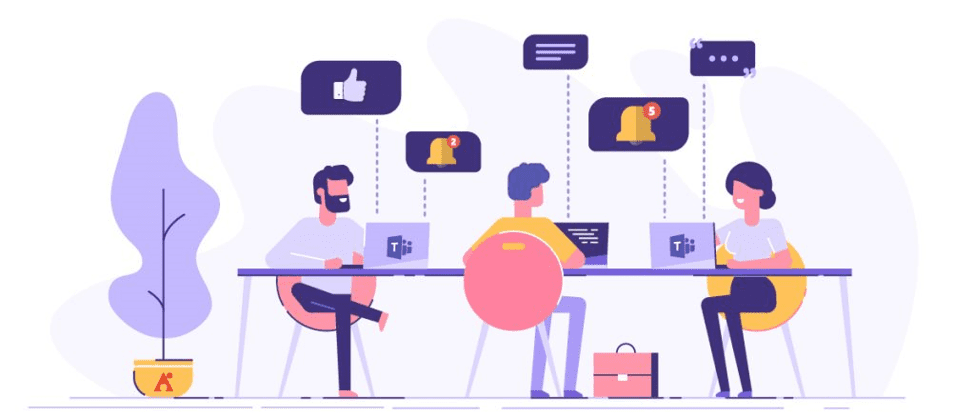I don’t know about you, but whenever I’ve taken an online learning course (synchronous or asynchronous), I’ve often felt let down and even at times frustrated. This can come from the low production quality of the material, but it’s mostly because the course materials didn’t explain how to apply task concepts for when I’m back working in real on-the-job conditions. In other words, it didn’t include performance-based material. This feeling of not being enabled to perform or behave differently after training is a widespread issue. Training is often lacking in the areas of:
- No info on how to apply the training to your workflow
- No “learn more” materials to go deeper into the topic
- No authentic practice
- No context or experiences
While remedying these areas would be extremely helpful in creating real change and would have made the time spent in training worth it, what I find even more disappointing is that there’s no quick and convenient way to ask any questions, especially after the training when I’m faced with a situation where I need answers. Having been in learning and development for 20 years, I’ve seen this a lot.

For those who are creating the training, I get that it can in fact be really challenging to build out performance-based/behavior-changing materials. Sometimes the stakeholder only demands “a course,” and other times you’re not given access to the right people who could provide the details needed to build the additional information in a way that is performance-focused. Sometimes you have a hefty backlog of training courses to be built and you just need to move on. Oftentimes there’s no integration between the environment where the course was taken (in the LMS) and the learner's workspace, thereby limiting your capability to create collaborative learning spaces where learners can get the information they really need.
Empowering Learners
In the absence of performance-focused materials, we must give learners an easy way (one-click) to connect, ask questions, collaborate, and fill in those gaps with each other's perspectives, experiences, and knowledge. In this way, we can also help learners build connections throughout an organization and set them on a path of self-reliance.
Ideally, you’d want to create a way for this to happen out in the daylight and not locked away in the LMS or a private conversation. Doing this will also benefit the folks in learning and development and the business unit as they too will be able to see those conversations and glean information from them. And if you can provide this capability in the flow of the learner's digital workspace that’d be even better because that’s where a “moment of need” will most likely arise.

A few years back when I took a position at a different organization it was recommended that I take a specific course for onboarding. I finally made my way to the course (a story for another blog post) and while the media fidelity was low, I still enjoyed it and did in fact learn from it. The course was chock full of geeky information that built upon what I had already known, and within weeks of taking that course and learning more about the company and how they do business I was reflecting on this geeky goodness because it was time for me to perform my job.
In this reflection, it was clear that what I learned was not forme, but it was rather what the SME wanted fromme, which had little to do with performing my job. I went to the manager with questions and got no answers but heard plenty of praise for the SME. I tried to get in touch with the SME but access was highly limited. Being new, a little more time went by before I finally made a buddy who had been at the company for a few years. I had a chat with him about what I took away from that specific course and was comfortable enough to ask if he actually provides all of what the SME was seeking. His response: “Oh no, you don’t need to do that, just do this.” WHAT?!?!
Lessons Learned
As you just read, the course that I took sent me in a direction that left me with uncertainty, and a single short chat (weeks later) completely changed my understanding and ultimately how I performed my job going forward. When we open channels of communication associated with a course or included as part of a learning path, we can connect learners to the knowledge and expertise they need to perform tasks and produce results - even in the absence of performance-based materials. You can do this now by leveraging your collaborative workplace platform. The benefits will extend well beyond being able to provide answers for learners who have questions.

When you start to think about creating training materials to be launched from an LMS that’s integrated with the capabilities of your collaborative digital workspace (e.g. Microsoft Teams), you’re able to broaden the way you think about designing those materials. When you do this, you can start to build meaningful peer-to-peer collaboration opportunities and communities of practice. Tying the content from the LMS to the collaborative platform will also produce an environment where learning can happen easily every day and in the flow of work. Want to see how we make this happen? Reach out to us.
Do you have an experience similar to the one I shared above where you were greatly disappointed with a collaborative learning experience? Share it with me and it might be included in my next blog post!



